ARCHIVED: Chapter 3. Selection Of Pavement For Recycling And Recycling Strategies
| << Previous | Contents | Next >> |
Introduction
All pavements deteriorate over time due to traffic and environmental factors. Rehabilitation is needed to maintain the pavement at a certain condition. As mentioned in chapter 1, rehabilitation may be required for any one or more of the following reasons:(1)
- Inadequate ride quality.
- Excessive pavement distress.
- Reduced coefficient of friction between tire and pavement.
- Excessive maintenance requirement.
- Unacceptable user costs.
- Inadequate structural capacity for planned use.
- Inadequate capacity to carry projected traffic volumes.
There are large numbers of rehabilitation alternatives available for asphalt pavements.(1) As shown in figure 3-1 recycling is only one of the several rehabilitation alternatives.(2) Some of the other common methods are thick or thin hot mix asphalt (HMA) overlay. The HMA overlays may be dense graded or open graded, as shown in figures 3-2 and 3-3 respectively. Cold milling (figure 3-4) is also used as a rehabilitation technique. The choice of the rehabilitation alternative depends on observed pavement distress, laboratory and field evaluation of existing material, and design information.(2) Also, maintenance of geometrics and original thickness of pavements, especially in underpasses, influence the choice of rehabilitation method. HMA overlays can be used with or without milling or recycling. Except asphalt surface recycling, all other recycling methods such as hot mix or hot in-place or cold in-place recycling, have the potential to improve the structural capacity of pavements. In addition to this, recycling has some unique advantages which are not available with other types of rehabilitation techniques.
Figure 3-1. Rehabilitation alternatives.
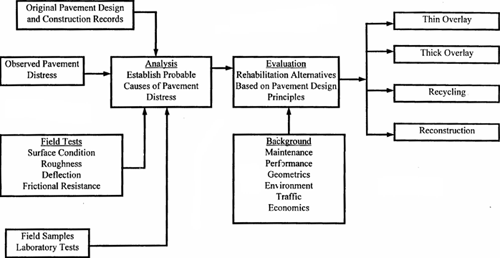
Figure 3-2. Dense-graded HMA overlay.
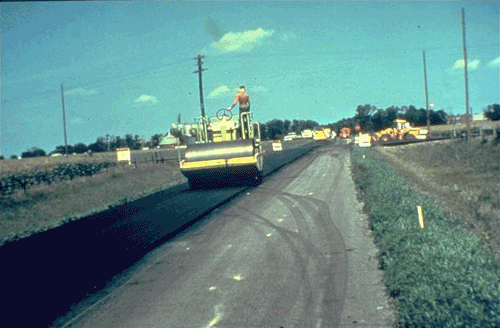
Figure 3-3. Open-graded HMA overlay.
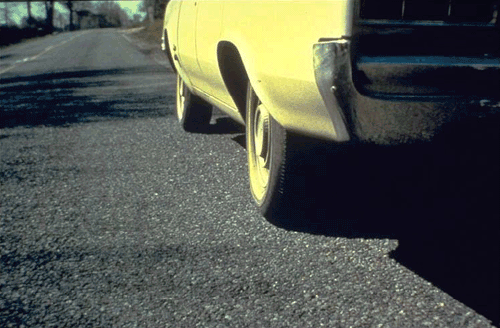
Figure 3-4. Cold milling.
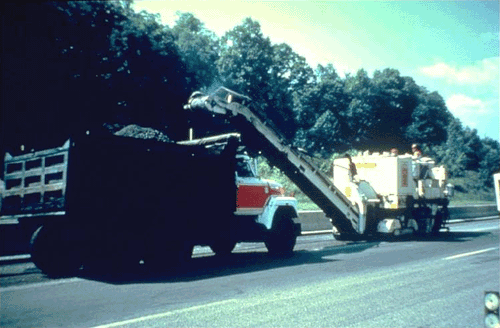
Some of these advantages are:
- When properly used, recycling can result in substantial savings over the use of new materials. Also, the cost of haulage can be avoided if recycling is performed in-place. The need for economic consideration is felt now, more than ever, because of tightening budgets and ever increasing costs of materials.
- Recycling can help in conservation of natural resources by cutting down the need for new materials. This translates to substantial savings in aggregate resources and demand for asphalt binder, especially during supply interruptions. Even though there may be an abundant supply of aggregates, the distribution of these sources does not always coincide with the location of need. A pavement recycled by cold process may need about one to three percent of asphalt binder compared to about six percent for a new asphalt concrete pavement This amounts to savings of about 10 gallons of asphalt binder per ton of the mix.(3) Cold recycling can also substantially reduce energy consumption by the pavement industry.
- Recycled materials have proven to be at least equal to new materials in quality. An HMA overlay on recycled base may perform better than an HMA overlay on the existing surface, even though they are of the same thickness, because the former, being less stiff, can substantially reduce the potential of reflective cracking through the surface course.
- Recycling can maintain pavement geometrics as well as pavement thickness. The existing pavement structure can be strengthened by recycling without adding substantial overlays. In some cases, the traffic disruption is lesser than that for other rehabilitation techniques.
Over the years recycling has become one of the most attractive pavement rehabilitation alternatives. With the continuous accumulation of performance data, field and laboratory evaluations of recycled mixes, and with the simultaneous development of realistic performance-oriented guidelines it is expected that recycling will continue to be the most attractive rehabilitation technique.
Since recycling can also be combined with the use of overlays, the process of selection of rehabilitation technique involves recycling methods as well as recycling with overlay or without overlay, or some treatment without recycling. Table 3-1(4) shows the different pavement maintenance and rehabilitation method available for asphalt concrete pavements to address specific pavement distress problems. Structural recycling refers to both hot and cold recycling. The choice of rehabilitation technique should be based on engineering considerations, economic considerations, and energy considerations. A discussion of these three considerations follows.
| Problem | Possible Cause | Maintenance1 | Rehabilitation2 | |||||||||||
|---|---|---|---|---|---|---|---|---|---|---|---|---|---|---|
| Structural Failure | Mix Composition | Temperature or Moisture Changes | Construction | Patching & Routine Maintenance | Fog Seal | Surface Treatment | Slurry Seal | Surface Recycling | Thin Overlay | Open Graded Surface | Structural Overlay | Structural Recycling | Reconstruction3 | |
| Alligator Cracking | x | x4 | x5 | x5 | x | x | x | |||||||
| Edge Joint Cracks | x | x | x | x | ||||||||||
| Reflection Cracks | x | x5 | x5 | x6 | x | x | ||||||||
| Shrinkage Cracking | x | x | x | x | x | x6 | x | x | ||||||
| Slippage Cracks | x | x | ||||||||||||
| Rutting | x | x | x | x | x7 | x | x | x | ||||||
| Corrugation | x | x | x | x | x8 | x | x | x | ||||||
| Depressions | x | x | x | x | x | |||||||||
| Upheaval | x | x | x | x | ||||||||||
| Potholes | x | x | x | x | x | |||||||||
| Raveling | x | x | x5 | x | x | x | x | |||||||
| Flushing Asphalt | x | x | x | x | x | |||||||||
| Polished Aggregate | x | x | x | x | x | x | ||||||||
| Loss of Cover Aggregate | x | x | ||||||||||||
Notes:
- Refer to Asphalt in Pavement Maintenance (MS-16), The Asphalt Institute, for details
- When cracking exceeds 40 percent of the surface area of the pavement
- If problem is extensive enough
- Deep patch-permanent repair
- Temporary repair
- When accompanied by surface recycling
- When rutting is minor
- Over planed surface
Engineering Consideration
The choice of a rehabilitation technique should be based primarily on the condition and performance history of the existing pavement. The major factors should include the following:(5)
- The present condition of pavement, based on ride quality and type
- The type, extent and severity of distress
- The structural condition of the pavement
- The environmental conditions of the region, primarily temperature and rainfall
- Drainage conditions of pavement, including surface and subsurface drainage
- Construction considerations, including restriction imposed by bridges (limited overhead clearance), and other structures such as curbs and gutters, drainage structures, shoulders, median barriers and guardrails
- The design life required for treatment
- The material used in original construction and planned for overlays
- The age of the pavement
- The type, frequency and cost of past maintenance activities.
The most common factors considered are (1) the present condition of pavement with regard to distress, (2) traffic in terms of equivalent 18-kip axle loads estimated for design period, and (3) structural capacity of existing pavement.(6)
Before choosing a rehabilitation alternative, the designer must evaluate environmental and drainage factors, and practical limitations imposed by contiguous structures. Since different rehabilitation techniques can produce pavements with different life cycle, the designer should consider the expected life of the pavement as well as funds available and user convenience. Design considerations are also dependent on the type of original surface (for example, PCC or asphalt) on which the new overlay will be placed. There is also the question of whether to use a separating course between the old surface and the new overlay. And finally, perhaps the most important consideration should be made of the type, amount and severity of distress conditions of the existing pavement. Since different recycling techniques can remedy different types of distresses, the most appropriate method should be considered.
Overlay design methods for improving the structural capacity of the existing pavement are discussed in chapter 18. These methods, together with methods for the design of new pavements, are also used to determine thickness requirements for recycled pavements.
Economic Consideration
Recycling techniques can be evaluated on the basis of the cost of the pavements. The cost, or worth, of a pavement can be defined in two ways: (1) present worth (PW), or the present value, and (2) equivalent uniform annual costs (EUAC). Present worth is defined as the money needed at present to fund all costs of the pavement. The equivalent uniform annual cost (EUAC) is an equivalent amount of money spread out over the analysis period.
The advantage of EUAC method is that alternatives with different lives can be conveniently compared, and prices for alternatives are in dollar value ranges that can be easily comprehended.
Life cycle costs of the rehabilitation alternatives must also be considered in economic analysis. The life cycle is the period of time of actual use before replacement, reconstruction, or extensive rehabilitation is required. Life cycle costs include the initial construction cost as well as the cost of maintenance activities during the life cycle.
Appendix A contains a detailed discussion of economic considerations including an example of life cycle cost analysis.
Energy Considerations
Even though recycling of pavements was performed as early as 1915, it was not until the mid1970s that widespread attention was paid to recycling because of the oil embargo. Recycling of HMA pavements results in a considerable conservation of energy by reducing cost of hauling and production of materials. However, the amount of savings depend on the particular type of recycling used. Energy considerations required for selection of a recycling method include the following operations which consume energy: material manufacture, material transportation, mix production, mix transportation, and mix placement and compaction.
The following energy requirement data for resurfacing and recycling operations have been reported:(3)
- Heater Planer - 3.5-7.0 kWh/m2 - 1.90 cm (10,000-20,000 Btu/yd2-3/4 in).
- Heater scarify - 3.5-7.0 kWh/m2 - 1.90 cm (10,000-20,000 Btu/yd2-3/4 in).
- Hot milling - 0.27-0.55 kWh/m2-cm (2,000-4,000 Btu/yd2-in).
- Cold milling - 0.14-0.35 kWh/m2-cm (1,000-2,500 Btu/yd2-in).
- In-place recycling - 2.1-2.7 kWh/m2-cm (15,000-20,000 Btu/yd2-in).
- Hot central plant recycling - 2.7-3.4 kWh/m2-cm (20,000-25,000 Btu/yd2-in).
The energy requirements for operations 1 to 4 only include energy associated with the equipment used for pavement removal. The preferred approach for calculation of the energy requirements of recycling operations is to use a step-by-step procedure for each phase of the operation using energy data.(3)
Considerations for Final Selection
The following factors should be considered prior to final selection of the rehabilitation alternative:
- Availability of equipment.
- Availability of experienced contractor.
- First cost.
- Life cycle cost.
- Traffic control.
- Length of construction.
- Impact on adjacent business.
- Utility relocation and interference.
Selection of a Recycling Method
If recycling is chosen as a rehabilitation alternative, there is a variety of recycling methods available for rehabilitation of HMA pavements. The primary options are hot mix recycling, hot in-place recycling (HIR), cold in-place recycling (CIR), and full depth reclamation (FDR). These recycling methods offer a number of advantages, which include the following.(7)
- Allow the use of existing material with the elimination of disposal problems.
- The asphalt mix may be improved through changes to the aggregate and/or asphalt binder.
- The pavement profile may be corrected and the ride improved.
- Cost reductions may be achieved over conventional rehabilitation methods.
The following section is divided into two parts. In the first part, each of the different recycling methods is discussed along with its advantages and disadvantages. In the next part, general guidelines for selection of a recycling process are presented.
Hot mix recycling or hot recycling is a method in which the RAP is combined with new aggregate and an asphalt cement or recycling agent to produce hot mix asphalt (HMA). Both batch and drum type hot mix plants are used to produce recycled mix. The RAP is obtained from pavement milling with a rotary drum cold planing machine and may be further processed by ripping and crushing operations, if needed. The mix laydown and compaction equipment and procedures are same as for conventional HMA. The ratio of RAP to new aggregates depends on the mix design, on the type of hot mix asphalt plants, and on the quality of stack emission generated. Typical RAP to aggregate proportions vary between 10:90 to 30:70, although a maximum of 50:50 have been reported for drum mix plants. The use of microwave technology has allowed the use of a higher amount of RAP, because the RAP can be preheated. The advantages of hot mix recycling are as follows.(8)
- Significant structural improvements can be obtained with little or no change in thickness by improving the existing asphalt materials.
- Additional right-of-way is not needed.
- Surface and base distortion problems can be corrected
- Performance of recycled mix is as good as conventional HMA mix.
Hot in-place recycling is a method which is performed on site with the RAP material obtained from the existing pavement. The deteriorated asphalt pavement is heated and softened to allow it to be scarified or mixed to a specified depth. If required, new hot mix material and/or recycling agent is added to the RAP material. In this method, the existing pavement is typically processed to a depth of 20 mm (¾ in) to 40 mm (1½ in). The process can be carried out as a single-pass or as a multiple-pass operation. In the single-pass operation, the scarified existing pavement material is combined with new material, if needed, and compacted. In a multiple-pass operation, the scarified material is recompacted and then the new wearing surface is applied after a prescribed interval. The advantages offered by this method include the following:(9)
- Cracks are interrupted and filled.
- Aggregate which has lost the asphalt binder coating through stripping, is remixed and recoated.
- Ruts and holes are filled, shoves and bumps are leveled, drainage and crowns are reestablished.
- Flexibility is restored by chemically rejuvenating the aged and brittle pavement.
- Aggregate gradation and asphalt content may be modified by some variations of this process.
- Enhances highway safety through increased frictional resistance.
- Reduces interruptions in traffic flow when compared to other conventional rehabilitation techniques.
- Hauling costs can be minimized.
- Aggregate and asphalt binders are conserved.
In the cold in-place recycling method, existing pavement materials are used along with recycling agent. The depth of treatment is typically from 75-100 mm (3-4 in). Although, in some cases, virgin aggregate may be added to the recycled material to change or improve the RAP characteristics, normally this procedure is carried out without transportation of any material except the recycling agent. The technique consists of pulverization of the existing pavement, sizing of the RAP, addition of recycling agent and the placement and compaction of the recycled mix. The newly developed recycling trains consist of large cold milling machine with a screening and crushing unit, and a mixing device attached to it. Conventional HMA laydown and compaction equipment are used to pick up the processed material from windrow, and subsequent placement and compaction. The advantages of cold in-place recycling include the following:(10)
- Significant pavement structural improvements may be achieved without changes in horizontal and vertical geometry and without shoulder reconstruction.
- All types and degrees of pavement distress can be treated.
- Reflection cracking normally is eliminated if the depth of pulverization and reprocessing is adequate.
- Pavement ride quality is improved.
- Hauling costs can be minimized.
- Old pavement profile, crown, and cross slope may be improved.
- Production rate is high.
- Only thin HMA overlay or chip seal surfacing is required on most projects.
- Engineering costs are low.
- Aggregate and asphalt binder are conserved.
- Energy is conserved.
- Air quality problems resulting from dust, fumes, and smoke are minimized.
- Frost susceptibility may be reduced.
- Pavement widening operations may be accommodated.
Full depth reclamation is a recycling technique in which all of the HMA layer and a predetermined amount of underlying materials are treated to produce a stabilized base course. The different types of additives which can be used for improving the quality of the base include asphalt emulsion and chemical agents such as calcium chloride, portland cement, fly ash, and lime. In some cases, new material is added to obtain a required depth of the improved base. In general, the technique consists of pulverization, introduction of additive, shaping, compaction, and application of a surface or wearing course. The advantages offered by full depth reclamation include the following:(11)
- Cost effective method for creating improved sections and ride quality.
- Eliminates potential reflective cracking of new overlays.
- Recycles existing materials saving natural resources and energy.
- Process is accomplished in-place.
- Heating, mixing, and hauling costs of conventional maintenance techniques can be eliminated.
- Roadway cross section can be maintained or adjusted; grade can be lowered in curbed sections to regain curbs or reshaped in poor draining sections to improve drainage.
- Emergency and local traffic can usually continue to use roadway during construction.
- Eliminate material disposal concerns.
- Improved resistance to frost penetration of subgrade.
- Savings realized by reducing total pavement thickness.
All of the different recycling techniques offer some advantages over conventional rehabilitation techniques. However, the choice of a particular recycling method should be primarily on the basis of the type of distress shown by the existing pavement. This is because all of the recycling methods are not equally suited for treating different types of distress, and hence the choice must be made for the particular method which is capable of rectifying the existing distress conditions. The applicability of a particular recycling technique not only depends on the pavement defect, but also on the extent and severity of the distress. For this reason, a comprehensive evaluation of the existing pavement is necessary before attempting any recycling process. Once the type, extent and diversity of distresses have been identified, candidate recycling procedures should be evaluated on the basis of their effectiveness and cost. The type of distresses recognized by ARRA are discussed in the following sections.(9) Attempt should be made to quantify pavement distress by using available methods such as SHRP pavement distress manual SHRP-LTPP/FR-90-001.(12)
Pavement distresses can be primarily grouped into six categories: (1) surface defects, (2) deformation, (3) cracking, (4) maintenance patching, (5) base/subgrade problems, and (6) poor ride/roughness.(1) The different terms are explained in the following sections.
- Surface defects: This type of defect includes raveling, bleeding (flushing), and skid hazard (slipperiness). Raveling is the progressive deterioration of the pavement surface caused by the loss of aggregate particles. Initially fine particles are lost followed by coarse aggregate becoming dislodged as the condition becomes more severe. Figure 3-5 shows a pavement with raveling. The cause of raveling is poor quality mixture, inadequate compaction, and excessive hardening of the binder. In the case of bleeding, an excessive amount of asphalt migrates to the pavement when the application rate was too high or cover aggregate loss has occurred. Figure 3-6 shows a bleeding surface. Loss of frictional resistance (skid hazard or slipperiness) occurs as a result of polished aggregate and resulting smooth pavement surface. This condition is particularly hazardous when the pavement is wet and has a film of water on the surface.
Figure 3-5. Raveling.
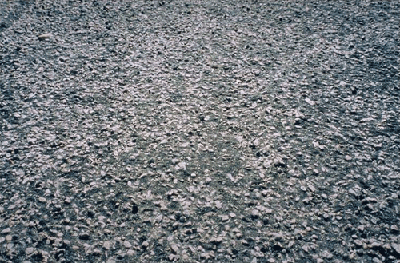
Figure 3-6. Surface bleeding.
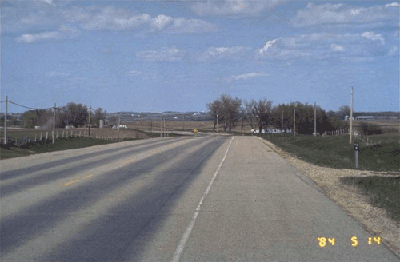
- Deformation: The different types of deformation include corrugations (wash boarding), wheelpath rutting and shoving. Corrugations are ripples formed laterally across an asphalt pavement surface. These occur as a result of lack of stability of the HMA at location where traffic starts and stops or on hills where vehicles brake downgrade. Figure 3-7 shows corrugation on a HMA pavement. The causes of the lack of stability are too much or too soft asphalt, a high sand content and excessive presence of smooth and rounded aggregate in the mix.
Shoving occurs as localized bulging of the pavement surface. A typical example is shown in figure 3-8. The cause of this type of distress is a lack of mix stability.
Rutting is the occurrence of longitudinal surface depressions or channels in the wheel path. Figure 3-9 shows an example of rutting. This distress may be caused by an unstable mixture with very low air voids or excessive wheel loads and tire pressure.
Figure 3-7. Corrugation.
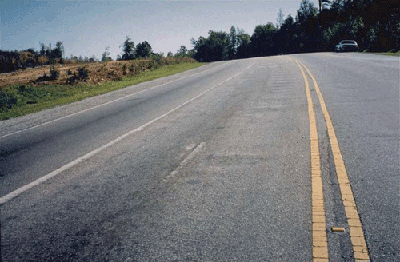
Figure 3-8. Shoving.
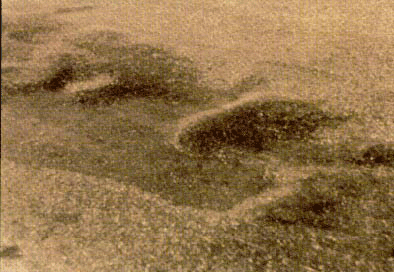
Figure 3-9. Rutting.
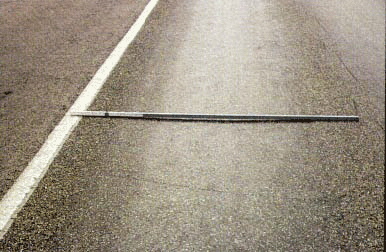
- Cracking: The different types of load and non-load associated cracks include alligator cracks, wheel path cracks, pavement edge cracks, slippage cracks, block cracks, longitudinal joint cracks, transverse cracks, and reflection cracks.
Alligator cracking is shown in figure 3-10. These are interconnected cracks that create a series of small pieces resembling an alligator's skin or chicken wire. This type of distress may be caused by excessive deflection of the pavement surface over an unstable subgrade or base courses of the pavement, or due to repeated loads that exceed the load-carrying capability of the pavement.
Wheel path cracks appear as fractures or separation within the wheel paths. The cracking begins as single or multiple longitudinal cracks and progresses with time to a pattern resembling alligator cracking.
Pavement edge cracks are longitudinal cracks within 0.3 to 0.6 mm (1 to 2 ft) of the outer edge of the pavement or at the joint between a pavement and widening. The cracking is due to the lack of lateral (shoulder) support, base weakness frost action, and inadequate drainage.
Slippage cracks are typically crescent or half-moon shaped cracks produced when vehicles brake or turn which cause the pavement surface to slide or push. This is caused by a low strength HMA or a lack of bond between surface and lower courses.
Block cracks are interconnected large cracks with sharp angles or corners. Figure 3-11 shows a typical block cracking. Such cracks occur due to shrinkage of asphalt mix because of volume changes in the base or subgrade.
Longitudinal joint cracks develop at construction joints because of poorly paved joint or improper construction technique. A typical example is shown in figure 3-12.
Transverse cracks occur across the pavement centerline and are caused by shrinkage from temperature changes and/or hardening of asphalt. Figure 3-13 shows a pavement with transverse cracks.
Reflection cracks are cracks in asphalt overlays caused by cracks in the pavement structure underneath. A typical example is shown in figure 3-14.
Figure 3-10. Alligator cracking.
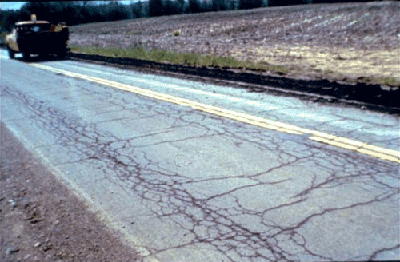
Figure 3-11. Block cracking.
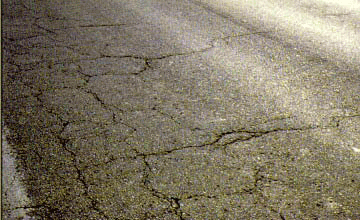
Figure 3-12. Longitudinal joint cracking.
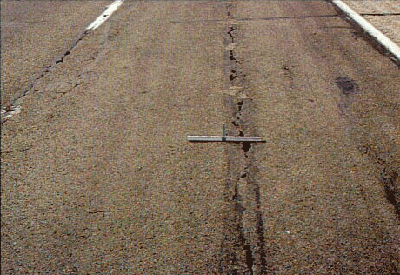
Figure 3-13. Transverse cracking.
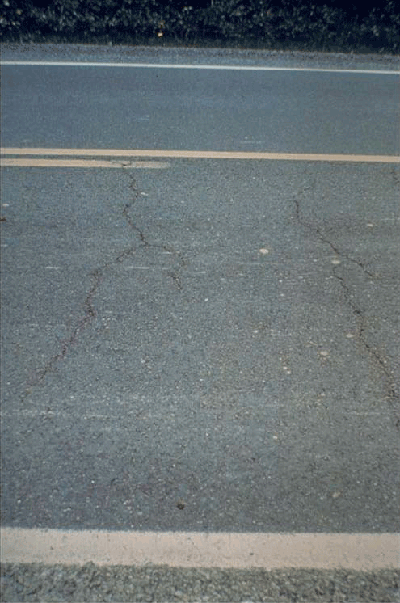
Figure 3-14. Reflection cracking.
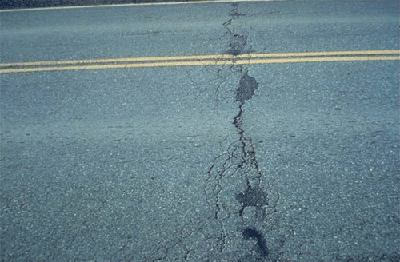
Maintenance Patching: A patch is an area of distressed pavement which has been repaired with new mixture (deep or pothole patching) or the placement of a thin overlay (skin patching).
The patching may be only a seal coating of the distressed area (spray patching). Figure 3-15 shows an example of maintenance patching.
Figure 3-15. Maintenance patching.
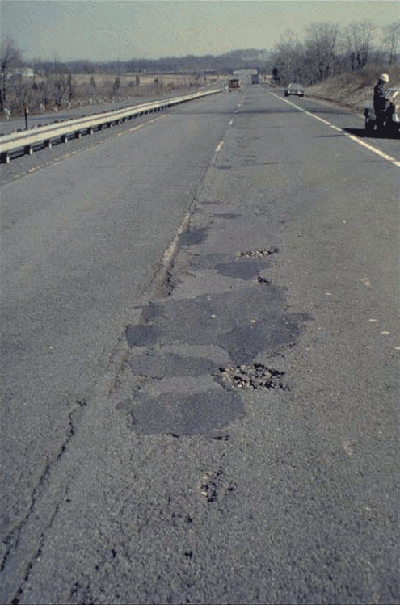
Problem Base/Subgrade: An unstabilized or poorly drained base or subgrade can result in severe cracking, settlement and rutting of an asphalt pavement. A wet, soft base or subgrade can result in very low strength and possible pumping/displacement of materials to the surface through cracks in the pavement.
- Ride Quality/Roughness: General unevenness is defined as the overall ride quality with consideration given to the general smoothness of the pavement. Depressions are low areas which were created during the paving operation or caused by localized settlement.
High spots are high areas in the pavement caused by paving operation or frost heaving or swelling of the subgrade soil.
Based on these distresses, the ARRA recommends table 3-2 as a guideline for selecting a recycling alternative. A detailed discussion of applicability for the use of different recycling techniques and considerations is presented in table 3-3.
| Type of Pavement Distress | Hot Recycling | Hot In-Place Recycling | Cold In-Place Recycling | Full Depth Reclamation |
|---|---|---|---|---|
| Surface Defects | ||||
| Raveling | x | x2 | ||
| Bleeding (flushing) | x | x5 | ||
| Slipperiness | x | x2 | ||
| Deformation | ||||
| Corrugations (washboarding) | x | x5 | ||
| Rutting - shallow3 | x | x5 | ||
| Rutting - deep | x | x6 | x6,7 | |
| Cracking/Load Associated | ||||
| Alligator | x | x | x | |
| Longitudinal - wheel path | x | x8 | x | x |
| Pavement edge | x | x | x | |
| Slippage | x | x9 | ||
| Cracking/Non-Load Associated | ||||
| Block (shrinkage) | x | x | x | |
| Longitudinal-joint | x | x10 | ||
| Transverse (thermal) | x | x | x | |
| Reflection | x | x | x | |
| Maintenance Patching | ||||
| Spray | x11 | x11 | x | |
| Skin | x11 | x11 | x | |
| Pothole | x | x | x | |
| Deep (hot mix) | x | x | x | |
| Problem Base/Subgrade (Soft, Wet) | x | |||
| Ride Quality/Roughness | ||||
| General unevenness | x | x | ||
| Depressions (settlement) | x12 | x12 | x13 | |
| High spots (heaving) | x12 | x12 | x14 | |
Notes:
- A pavement in which asphalt mixtures are used for all courses above the subgrade or an improved subgrade having portland cement, lime, lime-fly ash, fly ash or calcium chloride modification.
- Applicable if the surface course thickness does not exceed 1½".
- Rutting is limited to the upper portion of the pavement structure (top 1½ - 2").
- Rutting is originating from the lower portion of the pavement (below surface course and includes base and subgrade).
- May be a temporary correction if entire layer affected not removed or treated by the addition of special asphalt mixtures.
- The addition of new aggregate may be required for unstable mixes.
- The chemical stabilization of the subgrade may be required if the soil is soft, wet.
- Applicable if the cracking is limited to the surface course of the pavement.
- Applicable if the treatment is to a depth below the layer where the slippage is occurring.
- Applicable if the cracking is limited to the surface course of the pavement.
- In some instances, spray and skin patches may be removed by cold planing prior to these treatments (considered if very asphalt rich, bleeding).
- May be only a temporary correction if the distress related to a subgrade problem.
- Used if depressions due to a soft, wet subgrade condition.
- Used if the high spots caused by frost heave or swelling of an expansive subgrade soil.
| Process | Applicability | Considerations |
|---|---|---|
| 1. Hot Mix Recycling | Can be used to treat surface defects, deformation, load and non-load associated cracks, and maintenance patching. Material obtained from an existing pavement can be stockpiled for future use. Also, stockpiled RAP material can be carefully blended in a plant with other materials to achieve proper mix. | Percentage of RAP that can be used depends on recycling mix properties and the type of hot mix plant. RAP/virgin material blend is typically 10:90 to 30:70, with a maximum of 50:50 (drum plant). |
| 2. Hot In-Place Recycling | Can be used to treat surface defects, corrugation and surface rutting, and longitudinal and slippage cracking up to 50 mm (2 in) depth. The existing pavement material can be used fully, resulting in a minimal demand for virgin materials. Hence, substantial savings in transportation cost can be realized. This method can reduce rehabilitation time significantly, and is particularly suitable for busy highways or streets which cannot be kept closed for a long time. | Hot in-place recycling can involve significant amounts of heavy machinery and equipment. Because of high mobilization costs, there should be enough work in a particular area (either for a single project or for a number of projects) to make this process cost effective. Also, since this method frequently involves long equipment trains, it may not be suitable for local residential streets with very limited space for maneuvering of equipment . This process can produce air quality problems, for pavements with a significant amount of patches made with liquid bituminous materials and/or crack sealing material. |
| 3. Cold In-Place Recycling | Can be used to treat rutting in asphalt layers below the surface; load associated block and thermal cracks; and maintenance patching. The existing pavement material can be used fully and, therefore, substantial savings can be achieved by avoiding transportation of new materials. Also, since no heat is used in this technique, there are no air quality concerns associated with it, and savings are also realized in energy and money. This method can improve the structural capacity on an existing pavement. Also, disturbance to traffic is limited and can be used for busy highways which cannot be kept closed for a long time. | In most cases cold in-place recycled materials require a curing period, followed by an application of a wearing course. Although smaller machines are available, this technique can involve long trains which may not be suitable for local residential streets with very limited space for maneuvering of equipment. |
| 4. Full Depth Reclamation (FDR) | Can be used to treat rutting in layers below the surface, including base; load associated, block and thermal cracking; and maintenance patching. This technique is particularly suitable for pavements with base problems or insufficient structural capacity. Since this is basically a cold in-place process, it has all the advantages of cold in-place recycling, including savings in transportation cost and energy and no occurrence of air quality problems due to emissions. Different manufacturers have large single machines which can complete this process in a single pass. | Full depth reclamation usually results in a new base, which must be covered with an appropriate wearing course. As in cold in-place recycling, a significant amount of curing period may be required. At present, there is a lack of proper construction guidelines and specifications for FDR, and the whole process must be supervised by an experienced person. Since in this method, a part of non-asphalt layer is also recycled, the resulting mix must be carefully monitored for any contamination by undesirable material (such as vegetation or large chunks of RAP). |
Summary
Recycling is one of the many alternatives available for rehabilitation of pavements. Rehabilitation is required to keep pavements at a serviceable condition in terms of surface roughness, distress or frictional resistance. Without rehabilitation, pavements can deteriorate at a faster rate and ultimately cost much more to maintain than pavements maintained at a certain level of serviceability with the help of proper rehabilitation. Different rehabilitation alternatives include various types of seal coats. The particular choice of the rehabilitation technique should be based on life cycle costs and the one with the lowest life cycle cost should be considered. But simultaneously, engineering considerations should also be made. The important engineering consideration include present quality of pavement, type, extent and severity of distress, the amount of traffic, and the structural condition of the pavement. Economic considerations can be made by evaluating the cost of the pavement by any of the different methods such as present worth or equivalent uniform annual cost. The user costs and salvage value of the pavement should be accounted for. Consideration to energy requirements can also be made by calculating energy expenditure for each phase of operation. The choice of a particular technique also depends on availability of equipment, experienced contractor, initial cost, and construction impact on traffic. Except asphalt surface recycling, all other types of recycling can substantially improve the structural capacity of a pavement. In addition, recycling offers substantial savings in cost of material and haulage, helps in resource conservation, can improve pavement performance, and help maintain original pavement geometries and thickness. Recycling can be combined with overlays also. The relative advantages and disadvantages of the different recycling alternatives should be considered before making a decision. Among other things, the merits and demerits should include considerations about economy, removal of distress, effective quality control and traffic disruptions.
References
- American Association of State Highway and Transportation Officials (AASHTO). AASHTO Guide for Design and Pavement Structures, Washington, DC, 1986.
- J.A. Epps, R.L. Terrel, and D.N. Little. "Recycling Pavement Materials," Rural and Urban Roads, May, 1978.
- J.A. Epps, D.N. Little, R.J. Holmgreen, and R.L. Terrel. Guidelines For Recycling Pavement Materials, NCHRP Report 224, TRB, National Research Council, Washington, DC, September, 1980.
- Asphalt Institute. Asphalt Overlays for Highway and Street Rehabilitation, Manual Series No. 17 (MS-17), College Park, MD, June, 1983.
- Pavement Recycling Guidelines for Local Governments - Reference Manual, Report No. FHWA-TS-87-230, FHA, U.S. Department of Transportation, Washington, DC, 1987.
- F.H. Finn and C.L. Monismith. Asphalt Overlay Design Procedures, NCHRP Report 116, TRB, National Research Council, Washington, DC, 1984.
- Asphalt Recycling and Reclaiming Association. An Overview of Recycling and Reclamation Methods for Asphalt Pavement Rehabilitation, 1992.
- Asphalt Recycling and Reclaiming Association. Proven Guidelines for Hot Mix Recycling, 1992.
- Asphalt Recycling and Reclaiming Association. Guideline Specifications for Hot In-Place Recycling, 1992.
- J.A. Epps. Cold Recycled Bituminous Concrete using Bituminous Materials, NCHRP Synthesis of Highway Practice 160, TRB, Washington, DC, 1990.
- Asphalt Recycling and Reclaiming Association. Guideline Specifications for Full Depth Reclamation, 1992.
- Strategic Highway Research Program-Distress Identification Manual for the Long-Term Pavement Performance Studies, SHRP-LTPP/FR-90-001, October, 1990.
| << Previous | Contents | Next >> |

